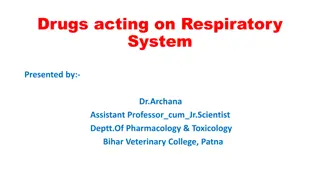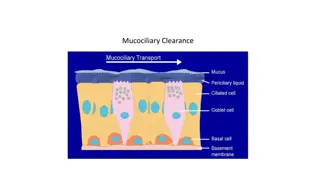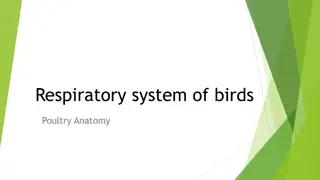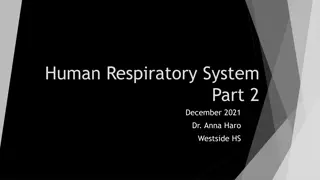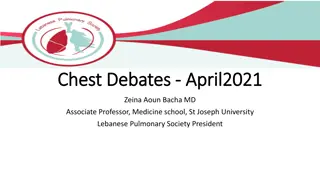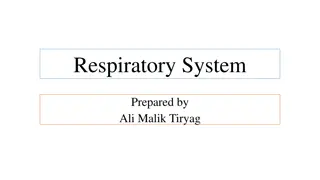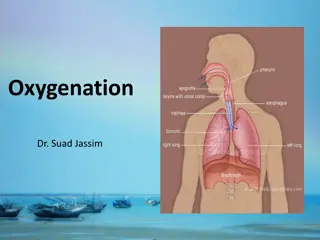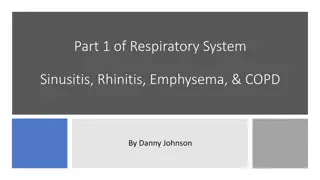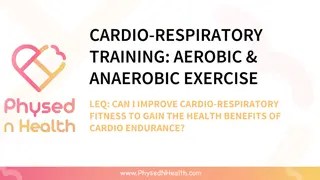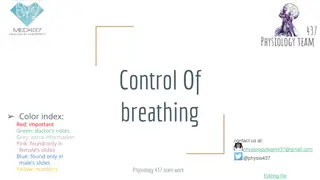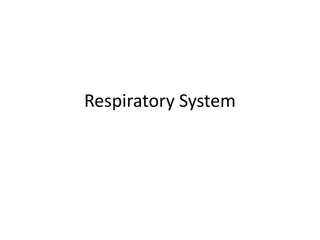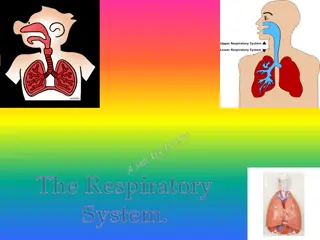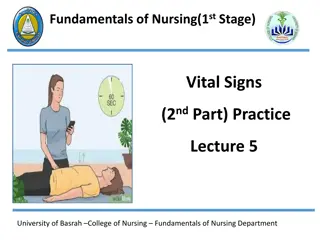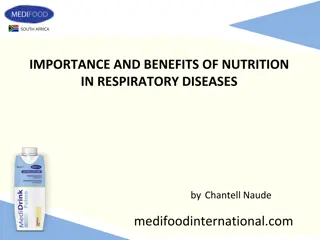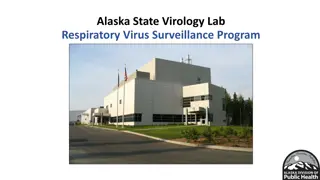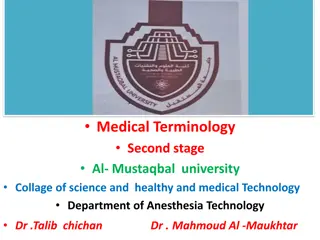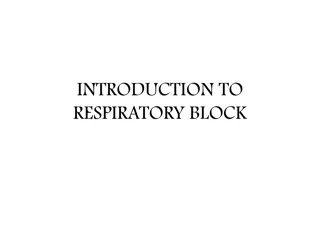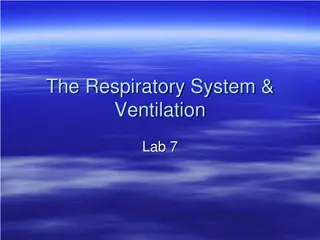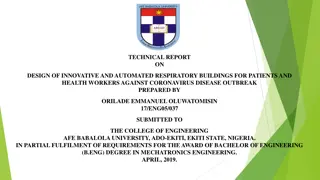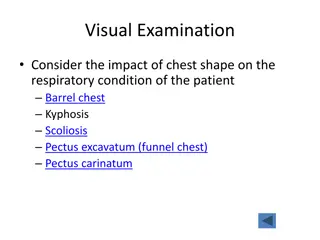Case Conference - ARDS and Hypoxemic Respiratory Failure in 34-Year-Old Male
34-year-old male transferred to MICU for hypoxemic respiratory failure with a history of asthma, recent respiratory symptoms, and suboptimal response to previous antibiotic treatment. Initial labs and imaging findings indicate a complex differential diagnosis involving multiple organ systems. Furthe
3 views • 24 slides
Understanding Acid-Base Balance in Health and Disease
Many critical illnesses can disrupt acid-base balance, indicating underlying diseases or organ damage. Interpretation of disturbances requires analyzing arterial blood gases, plasma electrolytes, and compensatory mechanisms. Acid-base disorders are classified into respiratory acidosis, respiratory a
3 views • 26 slides
Understanding Drugs Acting on the Respiratory System for Effective Treatment
Explore the classification and actions of drugs targeting the respiratory system, including antitussives, expectorants, respiratory stimulants, bronchodilators, and mucolytics. Discover how these medications work to suppress coughs, promote fluidity of bronchial secretions, and stimulate respiratory
0 views • 14 slides
Respiratory Health Imaging Studies and Evaluation
Explore a series of informative images showcasing various respiratory health evaluations and studies, including mucociliary clearance, cough clearance measured by gamma scintigraphy, pulmonary deposition of inhaled aerosol therapies, and assessment of fitted filtration efficiency using specialized p
1 views • 5 slides
Collaborating to Combat Sepsis: Role of Respiratory Therapists
Sepsis is a critical condition involving infection and inflammation, where the body's response causes widespread symptoms. Learn about the continuum of sepsis, its pathophysiology, and respiratory warning signs. Respiratory therapists play a crucial role in identifying and managing sepsis, with stat
1 views • 14 slides
Anatomy of the Respiratory System in Birds: A Detailed Overview
The respiratory system in birds, including poultry, consists of various components such as nostrils, nasal cavities, larynx, trachea, syrinx, air sacs, and lungs. Each part plays a crucial role in respiration, with unique features adapted to avian physiology. Understanding the anatomy of the avian r
1 views • 19 slides
Understanding Acute Respiratory Infections (ARI): Symptoms, Classification, and Transmission
Acute Respiratory Infections (ARI), characterized by sudden onset respiratory symptoms affecting the respiratory system from nose to alveoli, are a complex group of diseases caused by various agents. Symptoms include pain in the sinuses, nasal congestion, fatigue, sinusitis, coughing, and more. The
0 views • 16 slides
Understanding the Human Respiratory System: Anatomy, Functions, and Importance
The human respiratory system plays a vital role in gas exchange and maintaining overall health. This article delves into the anatomy of the respiratory system, its main functions, such as gas exchange and air filtration, and the importance of respiratory health. Learn about the different components,
0 views • 13 slides
Respiratory Health Insights and Updates by Dr. Zeina Aoun Bacha, MD
Explore key topics in respiratory health with Dr. Zeina Aoun Bacha, MD, including World Respiratory Diseases Day, Organizing Pneumonia, Sputnik Five Vaccine, and AstraZeneca Vaccine. Stay informed on important respiratory events and vaccination developments.
1 views • 10 slides
Understanding the Respiratory System: An Overview
The respiratory system, consisting of the upper and lower respiratory tracts, is responsible for ventilation and gas exchange. Learn about the anatomy, common symptoms like dyspnea and cough, and how the system functions anatomically and physiologically. Understanding these aspects can help in recog
0 views • 15 slides
Understanding Respiratory Hygiene: Key Stage 1 Learning Activity
Explore the importance of respiratory hygiene and how harmful microbes can spread through coughs and sneezes. Learn about good respiratory hygiene practices to prevent infection and engage in a hands-on learning activity to understand the concept better. This educational material is designed for Key
0 views • 17 slides
Understanding Oxygenation and Respiratory System Function
Explore essential terms like alveoli, perfusion, atelectasis, and more in the context of respiratory system function. Learn about lung anatomy, oxygenation processes, and common respiratory disorders like dyspnea and hypoxia. Discover the crucial factors for maintaining normal respiratory function.
0 views • 35 slides
Understanding Respiratory System Disorders: Sinusitis, Rhinitis, Emphysema, and COPD
This informative content delves into common respiratory issues such as sinusitis, rhinitis, emphysema, and COPD. It provides detailed information on the symptoms, diagnostic criteria, and rating formulas for each condition. The content also touches upon military service-related respiratory problems.
0 views • 15 slides
Sniff Nasal Inspiratory Pressure (SNIP): Assessing Respiratory Muscle Strength
SNIP is a sensitive non-invasive test that measures inspiratory muscle strength by assessing nasal pressures during a sniff maneuver. It is a valuable tool for early detection of respiratory muscle decline, providing insights into potential threats like hypercapnic respiratory failure, impaired coug
0 views • 11 slides
Enhancing Cardio-Respiratory Fitness for Optimal Health Benefits
Cardio-respiratory training through a combination of aerobic and anaerobic exercises can significantly improve cardio-respiratory fitness, leading to numerous health benefits including enhanced heart health, better mental well-being, and increased social engagement. Immediate and long-term advantage
0 views • 18 slides
Neonatal Respiratory Support Study Overview
This study focuses on evaluating the primary outcomes of length of hospital stay post-birth and incidence of severe respiratory failure in infants receiving respiratory support. Detailed logs are maintained daily until the infant is off respiratory support or discharged. The study is funded by NIHR.
0 views • 19 slides
Anesthesia and Upper Respiratory Tract Infections in Children
This presentation discusses the etiology, differential diagnoses, and management of upper respiratory tract infections (URIs) in children undergoing anesthesia. It covers causes of bronchoconstriction, adverse respiratory effects of URIs, and current anesthetic recommendations. The content emphasize
0 views • 52 slides
Respiratory Care in FSHD: Guidelines and Management Overview
Comprehensive overview of respiratory care in Facioscapulohumeral Muscular Dystrophy (FSHD) based on the American Academy of Neurology guidelines. Covers incidence of respiratory insufficiency, assessment of lung function, treatment options including noninvasive ventilation, and strategies for maint
0 views • 16 slides
Understanding the Control of Breathing and Respiratory Rhythm
The content delves into the intricacies of the control of breathing, emphasizing the role of the medulla oblongata in regulating respiratory activity. It explores factors modifying breathing patterns, respiratory consequences of changing PO2, PCO2, and pH, and the functions of central and peripheral
0 views • 16 slides
Understanding the Respiratory System Components and Functions
The respiratory system consists of two primary subdivisions: the Air Conducting portion and the Respiratory portion. The Air Conducting portion includes nasal cavity, naso-pharynx, larynx, trachea, bronchi, bronchioles, and terminal bronchioles, providing a pathway to and from the lungs while condit
0 views • 12 slides
Overview of Respiratory System Components and Functions
The respiratory system consists of vital components like pulmonary compliance and surfactant, crucial for proper lung function. Pulmonary compliance reflects the lung's ease of expansion, influenced by factors like lung elasticity and surface tension. Surfactant, produced by type II alveolar cells,
0 views • 15 slides
Understanding Respiratory Tract Infections: Causes and Prevention
Respiratory tract infections are commonly caused by viruses, bacteria, rickettsia, and fungi, leading to various health issues. These infections can be transmitted through droplets, droplet nuclei, and dust, emphasizing the importance of maintaining respiratory health through specific and non-specif
0 views • 34 slides
Understanding Nasal Cavity Histology and Respiratory Structures
The detailed information provided covers the histological structures of the nasal cavity, including the vestibule, respiratory mucosa, nasal septum, olfactory mucosa, and paranasal sinuses. It also delves into the microscopic structures of the wall of the trachea and primary bronchi. The respiratory
0 views • 11 slides
Respiratory Tract Anatomy Overview
The respiratory tract anatomy includes various structures like mucosa, submucosa, and adventitia in the trachea, bronchi, bronchioles, and terminal bronchioles. Each component has specific compositions and functions, ranging from respiratory epithelium to smooth muscle layers. The images provide a v
0 views • 15 slides
Understanding Equine Influenza: An Overview of Respiratory Tract Infections in Horses
Equine influenza is a contagious upper respiratory infection in horses caused by influenza viruses. This article covers the anatomy of the equine respiratory tract, signs, diagnosis, treatment, prevention, and prognosis of equine influenza. It also discusses the histological structure of the respira
0 views • 18 slides
Understanding the Respiratory System and Its Functions
The respiratory system is vital for gas exchange in the body, involving processes like pulmonary ventilation, external and internal respiration. It includes organs like the nose, pharynx, larynx, and trachea, which help in conducting air to the alveoli. This system facilitates the exchange of oxygen
1 views • 14 slides
Innovative Technology for Diagnosing and Managing Respiratory Diseases
Monash University researchers have developed a groundbreaking non-invasive technology to diagnose and manage respiratory lung diseases, such as cystic fibrosis and lung cancer. The technology, utilizing four-dimensional X-ray velocity imaging, provides high-definition real-time images of airflow in
0 views • 4 slides
Explore the Intriguing World of the Respiratory System
Discover fascinating facts about the respiratory system, including the anatomy of the lungs, how they help you breathe, and the interconnectedness of body systems. Learn how crucial oxygen is for sustaining life and how your respiratory organs work in tandem. Explore the essential role of the respir
0 views • 15 slides
Understanding Respiratory Rate and Ventilation in Nursing Practice
This lecture focuses on the vital signs related to respiratory rate, emphasizing the three processes of respiration: ventilation, diffusion, and perfusion. Nurses assess ventilation by observing the rate, depth, and rhythm of respiratory movement, crucial in recognizing normal thoracic and abdominal
0 views • 51 slides
Understanding Viral Infections of the Respiratory System
Respiratory viral infections are common and primarily caused by viruses, leading to morbidity and time off work. They can range from mild upper respiratory tract infections to severe lower respiratory tract infections like pneumonia. Various viruses like influenza, parainfluenza, respiratory syncyti
0 views • 23 slides
Pediatric Respiratory Infections: An Overview of Cases and Physiology
This review delves into selected cases of respiratory infections in children presented by Dr. David L. Smith, focusing on the anatomical and physiological aspects of the pediatric airway and respiratory system. It discusses respiratory failure in infants and small children, metabolic demands, cyanos
0 views • 49 slides
Importance and Benefits of Nutrition in Respiratory Diseases
Nutrition plays a crucial role in respiratory diseases such as COPD and CF, with malnutrition affecting a significant percentage of patients. Poor nutritional status is linked to increased morbidity and mortality in these patients, impacting pulmonary health and muscle function. MediDrink Pulmo offe
0 views • 7 slides
Alaska State Virology Lab Respiratory Virus Surveillance Program
The Alaska State Virology Lab's Respiratory Virus Surveillance Program accepts specimens from across Alaska, ranging from large hospitals to single physician clinics. They collect specimens representing CLI/ILI weekly and are interested in Severe Acute Respiratory Illness samples, among others. The
1 views • 6 slides
Designing Innovative Respiratory Buildings to Combat COVID-19 Outbreak
Explore the concept of designing automated respiratory buildings for patients and healthcare workers to combat the COVID-19 outbreak. Delve into the origins of COVID-19, its impact on human health, and the use of automated devices in treating respiratory diseases. Discover statistical data on corona
0 views • 16 slides
Understanding the Respiratory System: An Overview
The respiratory system comprises the upper and lower respiratory tracts, responsible for air movement and gas exchange. It relies on the cardiovascular system for proper blood flow. The anatomy involves structures in the upper and lower tracts, with common symptoms like dyspnea and cough indicating
0 views • 20 slides
Understanding Respiratory System Terminology and Disorders
Explore the terminology and components of the respiratory system including the upper and lower respiratory tract, respiration process, word roots, and common respiratory disorders. Learn the meanings of terms like apnoea, dyspnoea, pneumonia, and more. Enhance your knowledge of respiratory health an
0 views • 12 slides
Comprehensive Overview of Respiratory Block for Medical Students
This respiratory block introduces students to the anatomy, histology, muscles involved in respiration, embryology, radiological anatomy, and management of respiratory disorders. It covers topics like the nasal cavity, pharynx, larynx, trachea, bronchi, lungs, pleura, bronchial tree, and mediastinum.
0 views • 23 slides
Understanding the Respiratory System and Ventilation Lab Activities
Dive into the intricate workings of the respiratory system and explore various lab activities related to ventilation. From studying respiratory cycles to simulating spirometry, understanding muscle functions, exploring gas exchange in tissues, and controlling respiration, this comprehensive guide pr
0 views • 24 slides
Design of Innovative Automated Respiratory Buildings Against Coronavirus Disease
This technical report discusses the design of automated respiratory buildings to aid patients and health workers during the coronavirus disease outbreak. It explains the concept of respiration, the purpose of these systems, and the construction process. The aim is to ensure precise oxygen delivery a
0 views • 14 slides
Comprehensive Visual and Physical Assessment Techniques for Respiratory Conditions
This comprehensive guide covers the visual, palpation, auscultation, percussion, and pathological processes involved in assessing respiratory conditions. It discusses the impact of chest shape variations like barrel chest, kyphosis, scoliosis, pectus excavatum, and pectus carinatum on respiratory he
0 views • 6 slides


